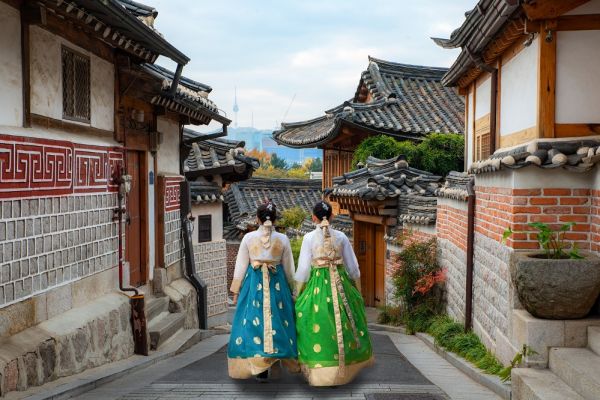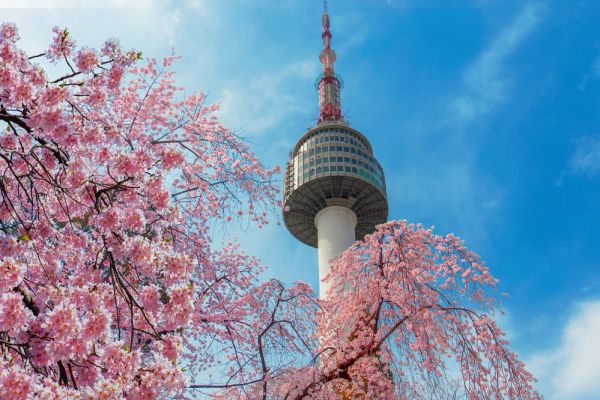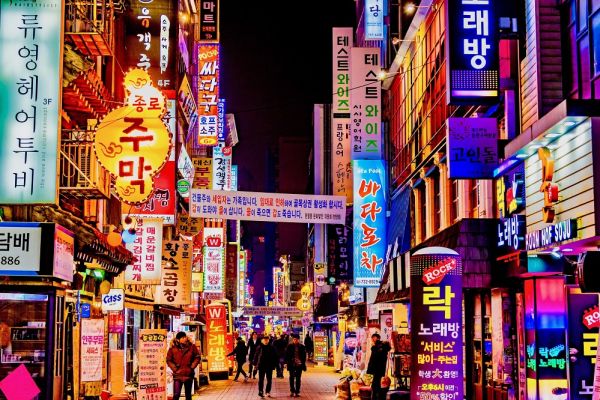SeoulTravel Guide
Seoul is one of East Asia’s must-see cities that’s a fascinating combination of opposites: modern cityscapes and high-rise buildings with mountains and natural wonders. Age-old Hangul traditions and military history with high-tech and future-looking attractions. South Korea’s capital is also a box-ticker for K-pop (Korean popular music), eclectic fashion, street food and the ultimate shopping sprees. There are so many cool things to discover in Seoul, so go on, dive straight into our travel guide!
Seoul quick facts
Language
National language
Korean
Beverages
Bottle of Coke/Pepsi (330ml)
GBP £1.19
Local time
Thursday
7:00pm
Currency
South Korean won
GBP £1.00 = KRW ₩1909.36
Eating out
Restaurant meal (casual dining)
GBP £6.28
Electricity
Plug type: C
2 pins • 220V
Explore Seoul
Where to stay in Seoul?
Looking for an immersive stay? Seoul offers you the unique experience of staying in traditional accommodation. Or are you perhaps a modern traveller, wanting to stay in a central location with big city lights and all the action? Seoul’s got that covered too.
For a chance to experience what it’s like staying in a traditional Korean homestead (hanok) with its characteristic wooden shutters, sloping tiled roof and decorative walls, and set in a manicured garden, book a stay at Rakkojae Hanok. This 140-year-old hanok is synonymous with its name that translates as ‘a place where one can enjoy the traditions of times past and rest one’s soul’. You can feast on authentic Korean cuisine, experience a tea ceremony, try making kimchi (traditional spicy fermented cabbage) or relax in the mud spa.
If upmarket is more your thing, Signiel Seoul, a five-star hotel in the Lotte World Tower (South Korea’s tallest building at 555.7 metres) is it! Offering panoramic views of Seoul’s cityscape and the Han River from rooms on the 76th to the 101st floors, Signiel Seoul offers you two fine-dining restaurants (a French and Korean 1 Michelin-starred restaurant), and a champagne bar. The luxurious double rooms have bathtubs overlooking the city, and are especially popular. Top tip: gaping at Seoul in all its glory as you bathe is best experienced with the lights down very low unless you want the visual experience to be the other way around. The hotel’s indoor pool is complemented with a gym and spa. While the hotel connects to Jamsil Subway Station, making it easy to get around, there’s much to do in the tower itself, including observation decks, cafés and bars.
How about a temple stay in a Buddhist temple that’s been around for more than a millennium? Bongeunsa, in the heart of Seoul, offers introductory and more ‘serious’ overnight stays for visitors looking to experience the Buddhist tradition and daily monastic life. A temple stay (the duration of which depends on the chosen programme) may include a digital detox, silent meditation, communal chores, art and craft activities, as well as vegetarian cuisine and a detox from any stimulants.
Believe us when we say, this is just the start. Book your Seoul accommodation today!
Things to do in Seoul
South Korea’s capital offers experiences of old and new, from art galleries to historical sites, cultural hotspots to skyscrapers. Whatever kind of traveller you are, you'll find your favourite things to do in Seoul and maybe even a few you've never thought about.
For an introduction to Korean culture that stretches back to the 14th century, make your way to Gyeongbokgung Palace, which translates to “palace greatly blessed by heaven”. This is the grandest (and oldest) of Seoul’s five grand palaces and makes for the perfect cultural immersion into this East Asian country. You could easily spend the day at the palace, especially as it’s home to the National Folk Museum of Korea, which hosts temporary exhibitions and performances alongside its permanent displays of life in South Korea through the ages. Don’t miss the daily ‘changing of the guards’ ceremony that happens at 10am and 2pm.
History buffs and those who like things that are a little eerie will be fascinated by the Demilitarised Zone – one of the world’s most heavily patrolled regions. North and South Korea lie on either side of a 4km-wide buffer zone that divides the peninsula along a 240-km border. Booking a tour will give you insight into the history of the war, a chance to walk along unfinished infiltration tunnels (built for invading the other side) and you can also visit the adjoining museum.
The N Seoul Tower, also called the Namsan Tower or Seoul Tower, is the place to go if you’re looking for views of the city and over the Han River, which dissectsthe city in two. Some say it is to Seoul what the Eiffel Tower is to Paris, not only because you can go to the top of the 236.7m-tall tower, but also because the viewing deck at its base is covered in thousands of padlocks inscribed with declarations of love. It’s one of the most romantic places in the city, especially at night when it’s illuminated.
Seoul’s contemporary art scene is world-renowned and spread across several districts. Samcheong-ro is the heart of it all and home to the oldest gallery, established in 1970 – Gallery Hyundai. From independent art galleries to massive exhibitions, art lovers will be spoilt for choice.
Looking for an immersive experience? Then a Seoul tour is the way to go.
Seoul food and drink
Restaurants in Seoul are an experience – don’t leave without trying Korean fare, whether it’s the fiery kimchi – a base for most Korean dishes – or octopus tentacles. While the markets are the best place for an authentic foodie experience, the Lotte World Tower has a selection of restaurants and bars with some of the best views in town.
Tea and tea ceremonies (known as darye) have become an integral part of Korean life since they were introduced from China in the 7th century. Expect to find tea shops, old and new, on every corner, but particularly along the narrow walkways that radiate from the main road of Insadong-gil in the quaint neighbourhood of Insa-Dong. It is here that you will find Osulloc, a minimalist tea house. No matter whether you choose a hot or cold tea, it’s served with chewy Korean rice cakes (tteok), syrup-drenched deep-fried cookies and puffed rice snacks. There is also a selection of cakes and pastries available. For something unusual, try omija cha – a five-flavour berry tea with a combination of sour, spicy, sweet, salty and bitter flavours.
Apart from dining at the two fine-dining restaurants found in Signiel Seoul mentioned earlier, the country’s tallest building offers a selection of other eateries from cafés and coffee shops to fast-food outlets and a variety of Korean restaurants, most of which are found between the first and the sixth floor of the Lotte World Tower Mall, as well as between the 119th and 123rd floors. 123F Lounge is certainly the most famous restaurant in the tower (and possibly in Seoul). Although it is rather pricey (as it requires an entrance fee to the top of the tower), the views are certainly worth it. The menu includes Western fare such as steaks, pastas, pizzas, and a wide selection of drinks and cocktails, which make it the ideal spot for a romantic dinner or a special occasion. Otherwise, if you’re a lover of chocolate, head over to the Guylian Chocolate Café (1st floor) with handmade chocolates and desserts on offer. There’s also the Sky Friends Café: Pasteur Milkbar (119th floor) known for delicious soft serve ice-cream, or enjoy a nightcap at Seoul Sky Café: Angel-in-us Coffee on the 122nd floor.
Generous portions of kimchi come standard with every traditional meal in South Korea – if you flew with Korean Airlines, it was probably served on your flight too. You’ll find plenty of it in Korean restaurants and street-food stalls at Namdaemun market – one of Seoul’s most popular (and largest) traditional markets. Try it in mandu (dumplings) straight from a bamboo steamer, in gimbap (a Korean fast-food take on sushi rolls) or in kimchi-jjigae, a hearty vegetable stew. Here you will see huge mounds of the powdered chilli, which is used to make the sauce in kimchi, alongside silkworm pupae and sannakji (octopus cut into small pieces, sprinkled with sesame seeds and doused in soya sauce). Garak Fish Market, southeast of the Seoul subway station, is a Korean culinary immersion. You can walk along the countless fish and seafood wholesalers on the lower level and once you’ve made your choice, it’s prepared for you, as you like it, at the many restaurants and kitchens on the second level. It’s best to go with the chef’s recommendation.
Get a real taste for the local cuisine by booking a Seoul tour.
Seoul through your eyes
Where to shop in Seoul?
If you’re looking to shop till you drop, Seoul is the perfect city to do so. You could quite literally spend days visiting the streets upon streets of makeshift and permanent market stalls and shops in Myeong-dong. If you’re looking for a fancier shopping experience and genuine international brands, make your way to Gangnam.
Whether you’re looking to buy the latest fashion, make-up and accessories, electronics and gadgets, or green tea, the modern shopping district of Myeong-dong is where throngs of tourists go shopping in Seoul, so pack light. If it’s on your shopping list, this is where you’ll find it. While the crowds can be somewhat overwhelming, coupled with music blaring from loudspeakers, street performers busking for some change, and the shouting of store hosts trying to get the attention of passers-by, the atmosphere is electric and it’s well worth a visit. Even if it’s just to experience the rush, before ducking into one of the quieter alleyways for a bite to eat at the many food stalls.
What would a visit to Seoul be without visiting Gangnam, you may ask? K-pop singer PSY put this well-to-do Seoul neighbourhood on the international map when he released his song Gangnam Style more than a decade ago. Since its establishment in the early 1970s, Gangnam has become Seoul’s financial centre and a popular tourist neighbourhood. Which is why the ginkgo-tree-lined Garosu-gil district is dotted with European-style cafés and restaurants serving international cuisine, as well as international fashion outlets.
When is the best time to travel to Seoul?
If you’re debating the best times to visit Seoul, it’s important to consider that Seoul’s climate consists of four distinct seasons, with a cold but relatively dry winter from December to mid-March (with averages of -2.4°C or 27°F) and a sweltering, humid summer (with averages of 24°C or 75°F) that’s characterised by monsoon rains between June and September. July is the wettest month. Monsoon season is known for very high humidity with a cloak of fog sometimes settling over the city during this time of year.
Spring is from March until May and based on the temperatures and the amount of rainfall, the best time to visit Seoul if you want to be out and about outdoors is from late May to early July and from late August to early October. Autumn in Seoul is from September to late November.
The gorgeous cherry blossoms Seoul is known for are in full bloom between March and April and if you want to experience one of the biggest traditional festivals in Korea, the Lunar New Year usually falls towards the end of January or beginning of February. Check the dates with our travel agents to make sure you don’t miss out on light shows, parades, a wealth of programmes being held at the royal palaces, folk productions and more.
Don't miss out. Book your Seoul flight today!
How to get around Seoul
Whether you want to do your sightseeing from a bicycle, or you prefer to use public transport, there are plenty of affordable and convenient ways to get around the city any time of day or night.
With 302 metro stations along 20 lines across its 372.5km length, Seoul’s subway system is one of the longest and busiest in the world, transporting more than 2.5-billion people each year, so it’s no surprise that it is one of the fastest, most convenient and affordable ways to get around using a rechargeable transport card. Plus, the electric trains have heated seats in winter! The subway is easy to navigate as each metro station has a name, number and colour.
Bike sharing services have become hugely popular around the world, and Seoul is no different. Seoul Bike (or Ttareungi) is a public bicycle rental system with over 40,000 bikes and some 2,600 stations located near subway stations and crowded areas. It’s ideal if you want to travel a short distance or only a few kilometres, without having to take other forms of public transport, which get particularly busy during peak traffic. And it’s really easy to use via the app, and affordable too.
Buses offer a convenient way to get around, with bus colours and numbers designating various routes. Tourists often use yellow buses to commute to tourist attractions, business districts, shopping areas, and subways and railway stations around a closed circuit. The express red buses travel from the city centre to suburban areas; green buses ferry passengers over shorter distances between subway stations and bus terminals; while blue buses coast along major roads and longer distances. Seoul also operates a very punctual night bus route, which operates from 11.30pm until 6am.
Privately-owned taxis are often stationed near busy subway and bus stations. Orange taxi cabs are regular taxis with regular fares, while black taxis with a yellow sign on the roof are deluxe taxis and therefore more expensive. Uber is common in South Korea, though Kakao T is even more popular and uses the same e-hailing principles via an app. It offers more affordable rates and added-value services, such as live traffic tracking, parking navigation, as well as bus and train schedules, ticket payment options, flight bookings, and more.
Let us help you organise your own wheels for exploring. Hire a car in Seoul today!










